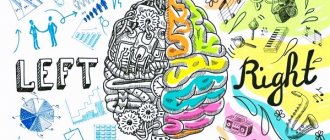Social mobility is a situation in which a person or group of people changes social status. In this case, a person can change his social stratum or remain in the same stratum and only his status will change.
Social status (or social position) is the position in society, in society, that a person (individual) or group of individuals occupies.
Social stratum is the division of people into classes or groups. The process of dividing society into layers or strata (Latin stratum - layer, layer) is called social stratification.
Types of social mobility
Vertical and horizontal
With vertical, a person changes his social stratum. Vertical mobility is divided into:
- individual (status changes for an individual);
- group (status changes for a group of people);
- professional (a person changes position at work - with a promotion or demotion);
- economic (a person’s level of well-being changes);
- political (when a person is promoted in public service, i.e. his level of power changes);
- upward (increasing social level);
- downward (lower social level);
- immobility (social status and position remain unchanged);
- intergenerational (children have a different social status than their parents);
- intragenerational (affects one person, his status changes throughout his life).
With horizontal mobility, there is no change in social stratum; a person only changes his social group. An example would be a situation when a person changes his place of residence, that is, moves to another area or city. Or when he changes jobs. Social status does not change. In this case we are talking about geographic mobility.
If a person moves and his social status also changes, this situation is called geographic migration.
Social mobility: types and mechanisms
Social mobility is the movement of groups or individuals in the social structure of society, as well as changes in their status.
It is traditional to distinguish the following types of social mobility:
- Vertical . It is typical for them to move their stratum to stratum in accordance with the level of income, prestige, power and education. Vertical mobility can be upward (increasing income level) and downward (decrease in income level, education, etc.).
- Horizontal mobility includes moving from stratum to stratum, which is not characterized by changes in social characteristics.
- Geographic mobility is a change in geographic location of residence.
- Individual (movement of one person into a stratum) and group (movement of a certain group of citizens).
- Intergenerational mobility. In this case, a person completely changes his own position in society in comparison with the status of his parents.
The main mechanisms of social mobility are hereditary and class ties, with the help of which the vast majority of the younger generation maintain their existing status positions. Direct movement from one class to another is not easy.
Today, the main emphasis in the mechanisms of social movements has completely changed, as a result of which it is aimed at the educational and professional training of the individual while simultaneously increasing the importance of individual criteria. In the course of professional advancement, an individual may find himself in a situation of need to acquire some recognition from the professional community, as well as constant professional self-development.
In the process of implementing these processes, the formation of mechanisms of social mobility occurs, which will provide opportunities for social movement of the individual.
Thus, the mechanisms of social mobility fully provide the individual with the opportunity for advancement.
Social mobility elevators
Russian and American sociologist and cultural scientist Pitirim Aleksandrovich Sorokin spoke about “elevators”, “stairs” or “paths” with the help of which people move and change their social status and (or) social stratum. Sorokin identified 7 main such paths:
- army (especially in wartime, when a successful military operation can lift a person up the social ladder, and vice versa, a loss can cause a loss of social position);
- church (history knows of cases when a low-class person became pope of the Roman Catholic Church);
- schools (in some countries, schools allowed promising children from poor families to achieve great heights (for example, China), in others, people from the lower strata were not allowed to receive an education (for example, India, England));
- political organizations/parties/groups (movement within a political organization or between different organizations as an example of career growth and change in social status);
- professional organizations/associations (for example, associations of medical workers, literary organizations, associations of musicians, scientists, lawyers, etc. The media have a special influence, which can quickly promote a person or just as quickly harm his social status);
- organizations for the creation of material values (in other words, groups of people who achieved success or moved up the social ladder due to the fact that they accumulated capital: gold, money and other valuables. With the help of this capital, titles, titles, privileges were purchased);
- family and marriage (for example, marriage with a person from a higher social layer will open access to this layer, from a lower one it can lead to the loss of social status).
Social mobility and its types
Definition 1
Social mobility is the process of changing a person’s social status.
P. Sorokin identified two main types of mobility:
- horizontal;
- vertical.
Horizontal social mobility represents the transition of an individual or a wider social group from one social position to another. At the same time, they remain in the same social stratum; only the fullness of their activity and its significance can change. An example is a transition from one religious group to another, a transition to another family, a change of residence. Vertical mobility is a set of interactions that ensure the transition of an individual or social object from one social layer to another.
Finished works on a similar topic
- Course work Social mobility: essence, types, role in society 430 rub.
- Abstract Social mobility: essence, types, role in society 220 rub.
- Test work Social mobility: essence, types, role in society 230 rub.
Receive completed work or specialist advice on your educational project Find out the cost
There are several other types of social mobility. Thus, professional vertical mobility manifests itself in a career, when the professional and labor status of an individual increases, his social status, and economic situation improves. Economic mobility is expressed in a significant improvement in well-being, political mobility is expressed in a transition to another level of power or to a higher social stratum, when an individual has new powers.
Society itself is capable of both raising and lowering social statuses. Younger, ambitious and enterprising people are pushing out those who do not possess such qualities from higher statuses. Both social rise and social decline can influence not only the life of an individual, but also entire social groups, the level of prestige of a profession or educational direction. Separately, organized social mobility is also distinguished, which is characterized by the state-controlled movement of individuals or individual social groups up and down, horizontally. Organized mobility can be carried out with or without the consent of individuals. But mobility in almost all cases is regulated, so it can be controlled by those people who find themselves in this situation and can move between social groups.
Do you need to select scientific articles for your academic work? Specify a topic and receive a response in 15 minutes get help
What influences social mobility?
Among the factors that influence social mobility, that is, the number of movements between social strata or the frequency of changes in social status, the following main ones can be identified:
- economic;
- historical;
- demographic;
- migration;
- location;
- nationality;
- the level of education;
- abilities and personal qualities of the individual (physical and mental).
Economic factor
The economic situation in the country directly affects the availability of jobs and professions in demand. If the economy requires, for example, highly qualified specialists, this will lead to people striving to fill vacant positions. Social mobility will become more active.
Historical factor
Historical events, such as wars and revolutions, have a direct impact on mobility. At such times, some people quickly climbed the social ladder, gaining great power or great wealth. That is, political and economic mobility occurred. Others lost their status. The most well-born nobles were deprived of their savings and privileges.
Mobility also depends on the type of society that has historically been present in a particular country. There are three types of society: closed, open and intermediate.
In a closed society, as a rule, status is assigned to a person at birth and changing it is extremely difficult or impossible. In the open, people actively move between social strata and change their status throughout their lives.
An example of an intermediate type is a feudal society, in which movements between classes or estates were not officially permitted, but they still occurred.
Demographic factor
Population growth affects social mobility. If a country experiences population growth, mobility also increases. Since young people are more willing to change their social class or status.
Adults are more likely to be economically mobile. Having accumulated money, they strive to change their living conditions for the better: move to a better area (geographical mobility) or take a high position (professional mobility).
It is a fact that the lower classes have higher birth rates. If there is a shortage of people in the upper strata, their places are taken by people who have climbed the social ladder, and not by those born into this class.
Migration
Countries with high migration rates tend to have active social mobility. Migrants create competition for local residents. Cheap labor creates a surplus of workers, forcing local residents to create a competitive advantage and move up the social ladder.
Location
In cities there are more opportunities to advance your career and change your financial situation. Young people tend to move to big cities in search of such opportunities. In this case, we can also talk about intergenerational mobility, when children achieve a higher status compared to the status of their parents.
Nationality
Even in a multinational state, preference is given to the nation whose numbers prevail in this state. People of this nationality more often occupy high positions and are promoted.
The level of education
The level of education can be a competitive advantage, regardless of the stratum in which a person was born. People with higher levels of education have a better chance of advancement. At the same time, they can also create competition for people from the upper strata who have not paid enough attention to their education, relying on their privileges or connections to get a job, position, or title.
The same is true in relation to the abilities of a person inherent from birth, or the personal qualities that he has developed in himself.
Topic 6. Social mobility
Unified State Exam 2018 in Social Studies - Social Relations
Social mobility
(Latin mobilis - mobile) -
movement of groups or individuals in the social structure of society, change in their status.
Types of social mobility
Vertical
– movement upward (
upward mobility
) or downward (
downward mobility
) on the socio-economic scale, associated with a change in place in the social hierarchy.
Horizontal
– geographical movement between regions, cities, etc. or change of positions at the same socio-economic level, i.e. without changing status (“professional careerism”).
Individual
– movements down, up or horizontally occur in each person independently of others.
Group
– movements occur collectively (for example, after a social revolution, the old class cedes its dominant position to the new class).
Intergenerational
– comparative change in social status among different generations (for example, the son of a worker becomes an engineer).
Intragenerational
– change in status within one generation (people, as a rule, achieve a new status through their own efforts).
Organized
– the movements of a person or entire groups up, down or horizontally are controlled by the state: with the consent of the people themselves, or without their consent.
Structural
– caused by changes in the structure of the economy and occurs beyond the will and consciousness of individual individuals (for example, the disappearance or reduction of industries or professions leads to the displacement of large masses of people).
Paths along which people move from one social group to another
, are called channels
of social mobility
, or
social “elevators”.
These include:
social status of the family;
getting an education; physical and mental abilities, external data of a person; receiving education; changing of the living place; military service; marriage .
Group mobility is influenced by social revolutions, foreign interventions, interstate and civil wars, military coups, changes in political regimes, the creation of empires, etc.
To quantify the processes of social mobility, indicators of its speed and intensity are usually used.
The process of mobility is often viewed from the point of view of the relationship between its speed and intensity. For this purpose, the aggregate mobility index
for a given social community. In this way, one can compare one society with another and find out which of them has higher mobility rates. Such an index is calculated for economic, professional or political areas of activity.
Social mobility may be accompanied by marginality
, which is understood as
a “borderline”, intermediate, structurally uncertain state of a social subject
.
The marginals
(from the French marginal - side, on the margins) include
individuals and groups excluded from the system of habitual social connections and located on the borders of social layers and structures
. There are the following types of marginals:
– ethnomarginals
– arise as a result of migration to a foreign ethnic environment;
– sociomarginals
– appear in connection with the incompleteness of social movement;
– economic marginals
– generated by loss of work and material well-being;
– political fringes
– arise due to the loss of generally accepted norms and values of political culture;
– religious fringes
– persons outside traditional faiths;
– biomarginals
– people whose health ceases to be a matter of concern on the part of the state.
In general, marginalized people experience great psychological stress and experience a kind of crisis of self-awareness associated with the loss of social identity. They may exhibit traits such as increased anxiety, excitability, aggressiveness, a desire to circumvent the law, etc.
Erecting social barriers and partitions, limiting access to another group or closing the group into itself
called
a social clause
(Latin clausula - conclusion). A clause simultaneously denotes a process and a result.
Social mobility is an important characteristic of a society, an indicator of the degree of its openness. In an open society, achieved status is highly valued and there are relatively wide opportunities for movement from one social group to another. A closed society gives preference to the prescribed status and makes it difficult in every possible way to move from one social stratum to another.
Sample assignment
C7.
Analyze the situation.
After graduating from the institute, the young man N. got a job as a manager in a commercial bank. After some time, he completed advanced training courses, after which he was appointed executive director of the bank. Changes also occurred in N.'s personal life: he married the daughter of the bank owner. What social process can this situation illustrate? What factors played a decisive role here? What are they called in sociology?
Answer:
This situation illustrates vertical upward mobility. The main factors that played a decisive role in this process are: obtaining an education, marriage with a person of higher status. In sociology, these factors are called channels (“elevators”) of social mobility.
Topic 7. Social norms →
← Topic 5. Inequality and social stratification
Topic 6. Social mobility
2.5 (50%) 2 votes
Add a comment
Social stratification
The process of dividing society into layers or strata (Latin stratum - layer, layer). There are economic, political and professional stratification.
Economic stratification involves dividing society into strata depending on income level. Political - depending on the power that a person or group of people has, as well as the ability to influence political decisions. With professional stratification, society is divided depending on the role performed at work: leader, subordinate.
Concept of social mobility
Scientific institutes and researchers of social disciplines usually call social mobility This process can be either positive for the entire life and social existence of a person, or negative.
For example, if an individual received an education, got a good job (in terms of organization and earnings), rose to an honorable position and became successful, then this indicates positive mobility. On the contrary, in the case when a successful person loses his job, divorces his family, is demoted, or falls to the level of an antisocial person, this indicates negative mobility.
The dependence of the concept of mobility in society on strata almost always shows at what level of the social status ladder a given individual is located, and how exactly he moves along it. This transition may be within the legislative framework or take place in complete violation of legal norms. Here everything depends on the level of a person’s upbringing, his environment, worldview, intelligence, consciousness, character traits and personal qualities.
People of different professions and levels of demand in society are always at different levels of mobility, even if they are employed in the same field.
For example, subjects belonging to the working class are never on the same level as managers - bosses and managers, since they are separated by such concepts as:
- education received;
- position held;
- professional prestige;
- completed socialization;
- presence of power;
- level of material income.
It should also be noted that social mobility depends on the existence of several interacting factors in the state:
- political;
- economic;
- cultural;
- legal;
- public
Each of these factors has a significant impact on a person’s life from a very early age, allowing him to decide on further goals and objectives based on his real capabilities. In the market conditions of capitalism, there is no specific program that would determine in detail the professional and everyday path of an individual, his communications with social groups and success. Here, a lot depends not only on education, but also on social activity, taking some steps forward, meeting the right people, personal charismatic character traits and luck. Sometimes one chance (for a job, for a grant for a project, for outside help) can turn a person’s life around 180°.
The concept of social mobility is actively researched and considered at different historical stages, since individuals by nature strive for a better life and desire material well-being for themselves and their families. This civilizational feature is inherent in man at all stages of his existence on Earth. And it is precisely this point - the achievement of good conditions and a prosperous material environment - that is the only significant factor in conditions of economic crises and existing instability.
The presence of constant financial security guarantees a person opportunities, a certain freedom, a chance to have power, receive a decent education and rank, and cultural and spiritual development. In the countries of the post-Soviet space, unfortunately, social mobility is directed towards immigration to established successful countries. The sad reality of the economic factor has clearly divided society into layers (strata), where the powerful “new Russian” gentlemen establish their own rules of the game and realities in which an ordinary person has to find himself in difficult living conditions.
Answers to the test: Social status of the individual
Final testing on the topic social status of the individual. The test covers questions closely related to the sections personality, sociology, and status. The building is designed to identify students’ acquired knowledge in the academic discipline fuel energy. There are a total of 19 questions in the test that require a correct answer. Our company’s specialists have already noted the correct answers, so you shouldn’t have any problems preparing for the upcoming test. If you still have any questions, you can write to us in the chat or call the hotline. Consultation is free of charge.
Test question: The process of personality socialization occurs:
Choose the correct answer:
[wrong] only in infancy;
[wrong] only in youth;
[true] all my life.
Test question: Which of the following is less characteristic of a post-industrial society?
Choose the correct answer:
[correct] industry;
[wrong] computer science;
[incorrect] service sector.
Test question: A person being interviewed in a sociological study is called:
Choose the correct answer:
[wrong] recipient;
[wrong] communicator;
[correct] by the respondent.
Test question: Who introduced the term “sociology” into scientific circulation:
Choose the correct answer:
[incorrect] M. Weber;
[incorrect] K. Marx;
[incorrect] O. Kont.
Test question: The central concept of K. Marx’s sociology is:
Choose the correct answer:
[correct] socio-economic formation;
[wrong] social action;
[incorrect] social space.
Test question: What is a change in a person’s social status called?
Choose the correct answer:
[wrong] career;
[correct] social mobility;
[incorrect] rating.
Test question: Social is:
Choose the correct answer:
[incorrect] characteristic of human consciousness due to nature;
[incorrect] any social phenomena determined by our aspirations;
[correct] characteristics of phenomena and processes that arise within the human community and are determined by the interconnections and relationships that arise in this system between people.
Test question: Which of the listed communities belongs to unorganized communities?
Choose the correct answer:
[incorrect] citizens of Russia;
[incorrect] airborne company;
[correct] homeless people.
Test question: Which of the listed terms is most closely related to the concept of a social institution?
Choose the correct answer:
[wrong] social processes;
[wrong] social stratification;
[correct] a set of social statuses and roles.
Test question: What is established in a society when there are no laws and norms in it?
Choose the correct answer:
[correct] anomie;
[incorrect] autonomy;
[wrong] disharmony.
Test question: A set of large social groups located hierarchically according to the criterion of social inequality is called:
Choose the correct answer:
[wrong] social structure;
[true] social stratification;
[wrong] social identification.
Test question: The property of a sample to reflect the characteristics of the studied (general) population is called:
Choose the correct answer:
[incorrect] validity;
[true] representativeness;
[wrong] sociometric.
Test question: Types of sociological survey include:
Choose the correct answer:
[incorrect] ranking;
[incorrect] content analysis;
[correct] survey.
Test question: When did sociology emerge as a science:
Choose the correct answer:
[incorrect] after World War II;
[correct] in the first half of the 19th century;
[incorrect] in the 18th century.
Test question: What is the subject of sociology?
Choose the correct answer:
[incorrect] person;
[true] social life of a person, group, society;
[wrong] society.
Test question: Social role is:
Choose the correct answer:
[incorrect] idea of what a person would like to achieve;
[true] certain functions that a person performs in a group, society;
[incorrect] what a person would like to do in life.
Test question: What is social structure?
Choose the correct answer:
[incorrect] organization of relationships between people;
[incorrect] pattern of behavior;
[true] a certain way of interaction between individuals occupying certain social positions and performing certain social functions.
Test question: What does a collection of large social groups provide?
Choose the correct answer:
[incorrect] social composition of the population;
[correct] social system;
[wrong] social organization.
Test question: Which of the following is classified as social institutions?
Choose the correct answer:
[incorrect] philatelist society;
[correct] family;
[wrong] rally.







